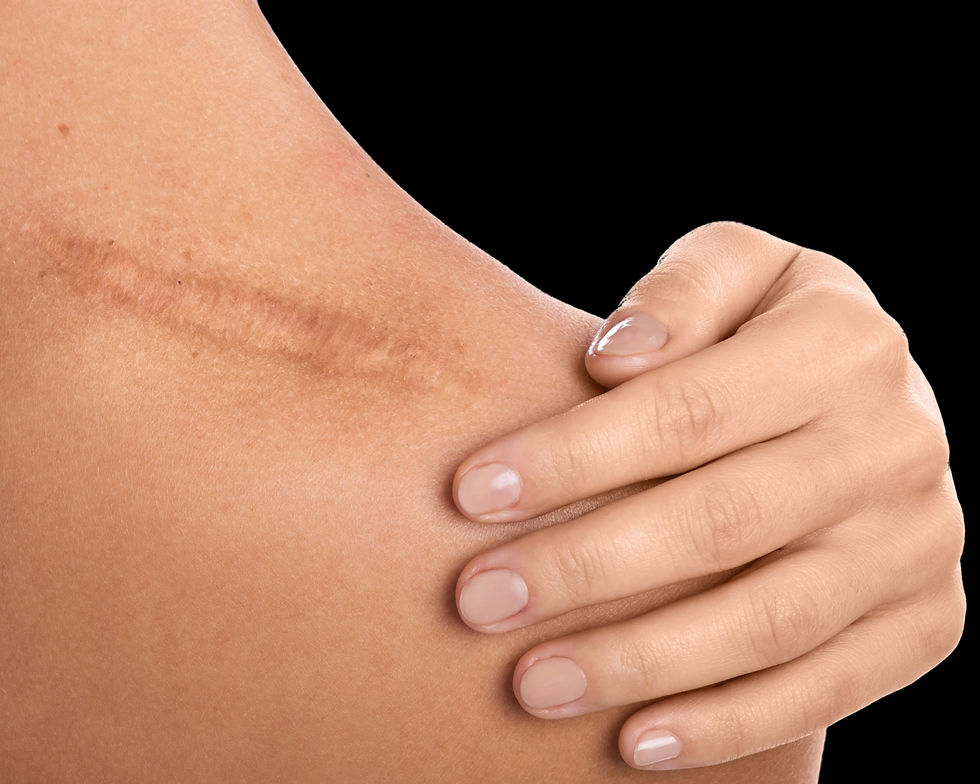Understanding the Different Types of Scars
- Karla Sesskin

- Feb 6
- 2 min read
By Karla Sesskin

Scars—our skin’s way of telling a story. Whether they’re reminders of childhood adventures, surgical procedures, or life’s unexpected moments, every scar has a history. But did you know that not all scars are the same? Understanding the different types can help you determine the best ways to treat or camouflage them, especially with the magic of paramedical tattooing. Let’s dive into the fascinating world of scars!
1. Hypertrophic Scars – The Overachievers
Hypertrophic scars are those that get a little too enthusiastic in the healing process. They are raised, thick, and stay within the boundary of the original wound. These scars often appear red or pink and may fade over time but can still remain prominent.
Common Causes:
Surgical incisions
Burns
Piercings
Possible Treatments:
Silicone sheets or gels
Corticosteroid injections
Paramedical tattooing to blend the color with surrounding skin
2. Keloid Scars – The Drama Queens
Keloid scars take hypertrophic scars to the next level! They don’t just stay put; they keep growing beyond the wound site, forming thick, raised bumps. Keloids can be itchy and sometimes even painful.
Common Causes:
Ear piercings
Acne or severe skin trauma
Surgical procedures
Possible Treatments:
Corticosteroid injections
Laser therapy
Microneedling (for flattening)
In some cases, paramedical tattooing can be used after flattening the scar
3. Atrophic Scars – The Sunken Souvenirs
Unlike hypertrophic and keloid scars, atrophic scars are depressed or sunken into the skin. This happens when the body doesn’t produce enough collagen during healing, leaving indentations.
Common Causes:
Acne
Chickenpox
Surgical procedures
Possible Treatments:
Microneedling or laser resurfacing
Dermal fillers for volume
Paramedical tattooing to create the illusion of smoother skin
4. Contracture Scars – The Tight Grippers
Contracture scars occur when large areas of skin are damaged, typically from burns. They cause the skin to tighten, which can limit movement and even affect muscles and nerves.
Common Causes:
Severe burns
Chemical exposure
Possible Treatments:
Physical therapy (to restore movement)
Skin grafting (for severe cases)
Paramedical tattooing to improve skin appearance
5. Stretch Marks – The Silent Warriors
Yes, stretch marks are a type of scar! They happen when the skin stretches or shrinks rapidly, causing collagen and elastin to rupture. While they start as red, purple, or pink, they eventually fade to silvery-white.
Common Causes:
Pregnancy
Rapid weight gain or loss
Growth spurts
Possible Treatments:
Topical creams and oils
Microneedling
Stretch mark camouflage tattooing
The Power of Paramedical Tattooing
For those who want to embrace their scars or make them less visible, paramedical tattooing is a game-changer. This specialized technique uses skin-toned pigments to blend scars with the surrounding skin, restoring confidence and creating a more natural appearance.
Embrace Your Skin’s Story
Scars are proof that you’ve healed, and each one tells a unique tale. Whether you choose to celebrate them, camouflage them, or learn more about them, knowledge is power. And if you’re interested in the artistry of paramedical tattooing, you’re in the right place!
Stay tuned for more beauty and tattoo wisdom here at Beauty Arts & Books. 💖



Comments